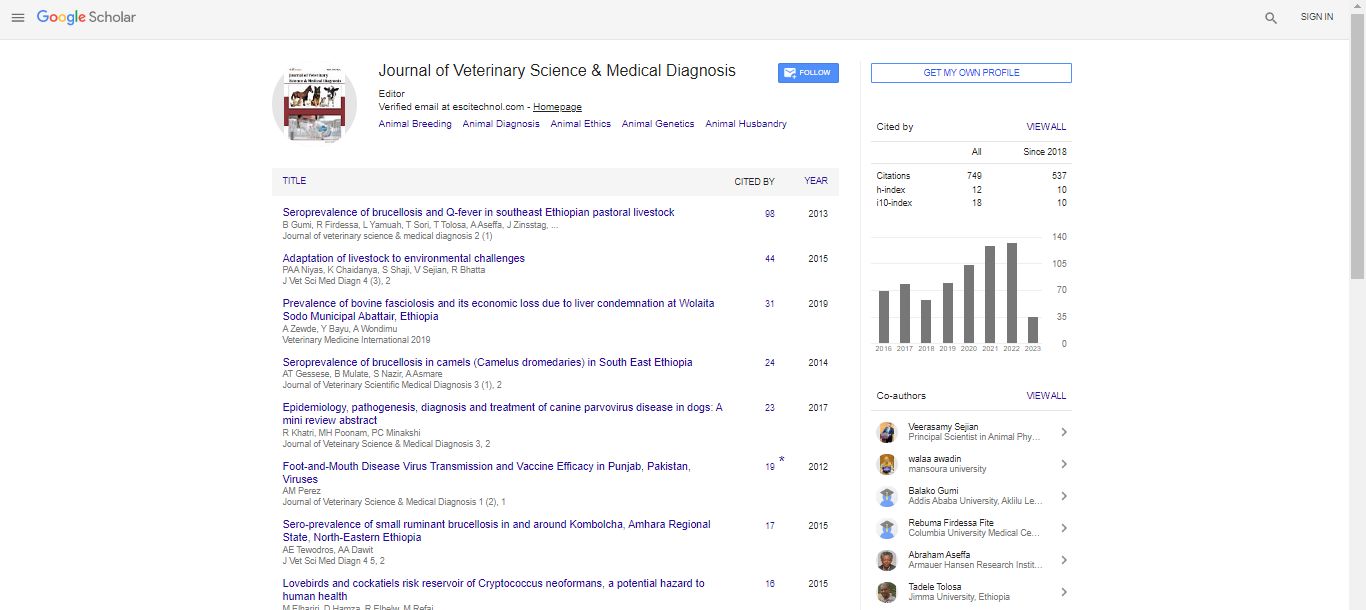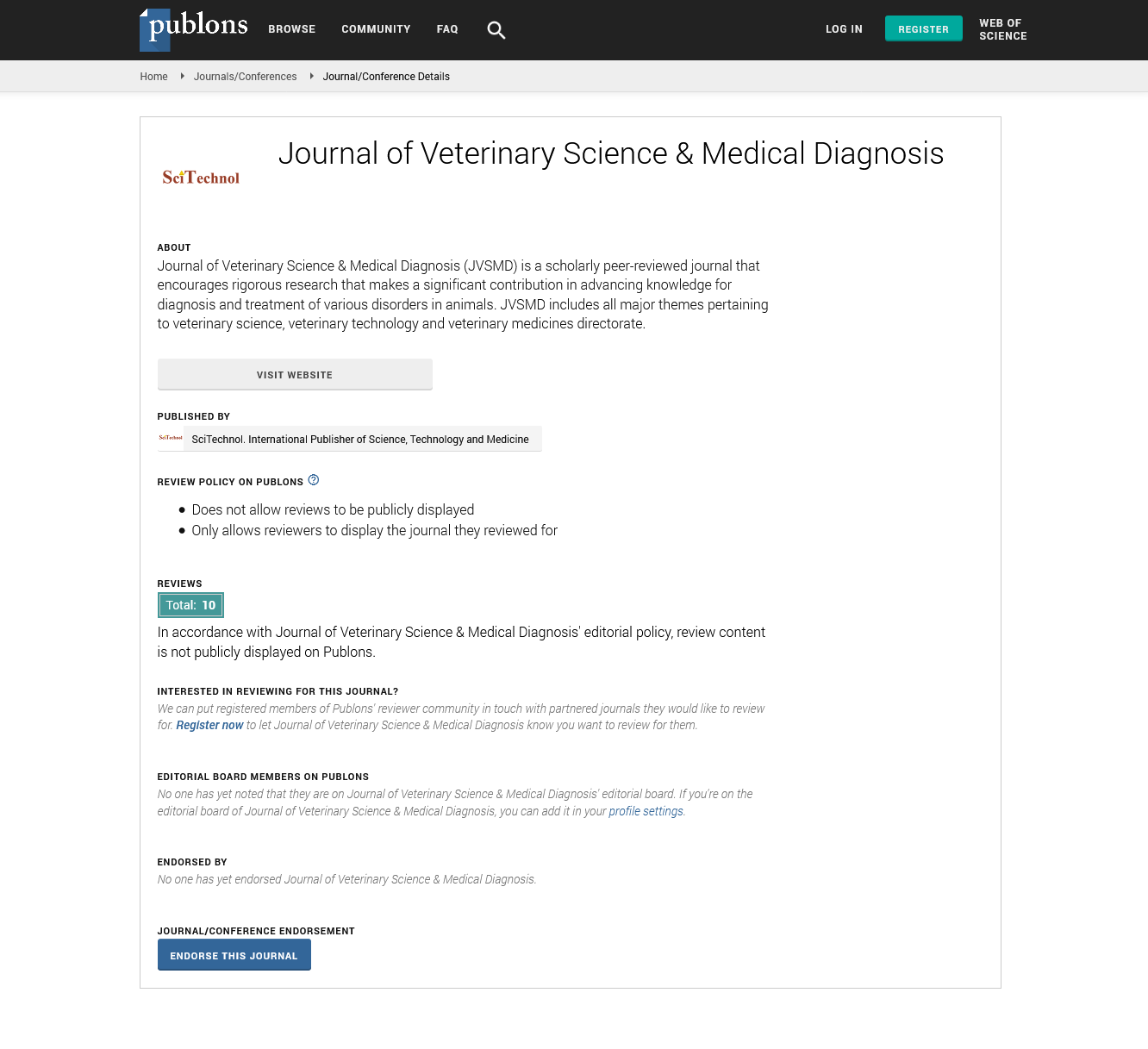Commentary, J V Vol: 13 Issue: 2
The Rise of Parasitic Infections in Farm Animals
Zahra Javed*
Department of Pathobiology, Ferdowsi University of Mashhad, Mashhad, Iran
- *Corresponding Author:
- Zahra Javed
Department of Pathobiology,
Ferdowsi University of Mashhad,
Mashhad,
Iran;
E-mail: zjaved@um.ac.ir
Received date: 13 March, 2024, Manuscript No. JVSMD-24-154237;
Editor assigned date: 15 March, 2024, PreQC No. JVSMD-24-154237 (PQ);
Reviewed date: 29 March, 2024, QC No. JVSMD-24-154237;
Revised date: 09 April, 2024, Manuscript No. JVSMD-24-154237 (R);
Published date: 16 April, 2024, DOI: 10.4172/2325-9590.1000097
Citation: Javed Z (2024) The Rise of Parasitic Infections in Farm Animals. J Vet Sci Med Diagn 13:2.
Description
Parasitic infections in farm animals have long been a significant concern for farmers, veterinarians and public health professionals. In recent years, however, the prevalence of these infections has been rising, posing new challenges to animal health, farm productivity and food security. Parasitic diseases in farm animals can lead to substantial economic losses due to decreased growth rates, reduced milk or egg production and higher veterinary costs. A common feature of all infestations is reduced efficiency of food utilization through reduction in food intake, though in some cases increases in nutrient requirement are induced as a result of damage to or loss of host tissue.
One of the primary reasons for the rise of parasitic infections is climate change. Warmer temperatures and altered rainfall patterns create more favourable conditions for parasites and their vectors. For instance, warmer winters allow for longer survival periods of parasites such as ticks, lice and gastrointestinal worms in the environment. Additionally, increased humidity can lead to a higher prevalence of parasitic organisms, particularly those that require moist environments for part of their lifecycle, such as certain types of nematodes. As climate change continues, these parasites are likely to spread to new areas where they were previously uncommon, thereby increasing the risk of parasitic infections in farm animals.
Changes in farming practices also contribute to the rise in parasitic infections. The intensification of livestock farming, with animals often confined in large, densely populated facilities, creates ideal conditions for the rapid spread of parasitic infections. These close quarters make it easier for parasites to transfer from one animal to another and in some cases, the accumulation of waste can lead to an increased parasitic load in the environment. Additionally, overgrazing in pastures can lead to contamination with parasite eggs, which are ingested by grazing animals. The practice of feeding animals in poorly maintained environments without proper sanitation increases the risk of infection.
The economic impact of parasitic infections in farm animals is considerable. Infections can lead to reduced weight gain in meat animals, decreased milk production in dairy cows and lower reproductive performance in breeding stock. In severe cases, parasites can cause mortality, particularly in young or weakened animals. Beyond the direct financial losses, parasitic diseases also result in increased veterinary costs, the need for more frequent treatments and potentially the loss of market access due to animal health concerns. The impact of parasitic infections can be particularly devastating in developing countries, where resources for managing and preventing these diseases are limited.
Preventing and controlling parasitic infections in farm animals requires a multi-faceted approach. Integrated pest management strategies, including rotational grazing, maintaining proper hygiene and using targeted deworming programs, can help reduce the risk of infection. Monitoring animal health regularly and adopting a preventive approach rather than relying solely on treatment can reduce the reliance on anthelmintics and slow the development of resistance. Additionally, research into new treatments and more sustainable parasite control methods is important to addressing the rising threat of parasitic infections.
In conclusion, the rise of parasitic infections in farm animals presents a growing challenge to animal health and agricultural productivity. Climate change, changes in farming practices and the development of parasite resistance to treatments are all contributing factors. Addressing these challenges requires a combination of better management practices, innovative research and a more sustainable approach to parasite control. By adopting these strategies, farmers can mitigate the effects of parasitic infections and ensure the health and productivity of their livestock.
 Spanish
Spanish  Chinese
Chinese  Russian
Russian  German
German  French
French  Japanese
Japanese  Portuguese
Portuguese  Hindi
Hindi 
